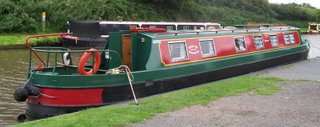So here I am in England, Liz who works in our department came the other day and said, ‘I am off on my holiday’. I asked ‘where are you going? Majorca or some such place?’ She said, ‘No, I will be on my canal boat’. I was wondering what on the earth she was talking about. I did recall passing a canal with some brightly coloured miniature boats the other day, so I asked Liz ‘you are going to spend a vacation on one of those, are they big enough?’ She said ‘of course, they are, we live & spend days on one and boat around the canals. We have a community and meet for supper in designated canal side pubs’..
‘It is really nice, you must try it’ she added. Well…I wondered...
 No, I did not, but I looked it up. Today there is a community of some 27,000 boats, all used for pleasure. These boats are modern diesel engine versions with bedrooms, bathrooms TV, Internet and could (depending on size) sleep 2-12 persons!! They ply the British canal network which were originally manmade for transporting goods through the Industrial revolution in the 18th - 19th century. All sounds fine right, till you hear about the dimensions. The minimum width of canal can be just about 7 feet. So what would the boat feel like? Pretty narrow, right? Yes it is and that is why it is also called ‘narrowboat’. If it is narrow then how do you have all of the above? It has to be plenty long (20-40ft) and you guessed right, some call it longboat…
No, I did not, but I looked it up. Today there is a community of some 27,000 boats, all used for pleasure. These boats are modern diesel engine versions with bedrooms, bathrooms TV, Internet and could (depending on size) sleep 2-12 persons!! They ply the British canal network which were originally manmade for transporting goods through the Industrial revolution in the 18th - 19th century. All sounds fine right, till you hear about the dimensions. The minimum width of canal can be just about 7 feet. So what would the boat feel like? Pretty narrow, right? Yes it is and that is why it is also called ‘narrowboat’. If it is narrow then how do you have all of the above? It has to be plenty long (20-40ft) and you guessed right, some call it longboat… Think of this, a narrow canal, a long and narrow boat.. So you just go one way is it? Oh.. NO! You have places (winding holes) where you can turn and BTW, the canal has different depths and is at different heights. So to navigate these, you have to pass through ‘locks’ and thus even go uphill.. Then there are tunnels to pass through…
I mentioned diesel powered, so how was it in the 18th century? A horse walked along the side of the canal on a ‘canal path’ and pulled the boat laden with goods. It was all very complex, read this to figure out how it worked when another boat & horse came head one. Also, these were then called horseboats!
Like somebody said, it is the fastest way to slow down…travelling at 4mph. Now you understand the concept of a canal holiday, I presume???
Pictures (courtesy Wikipedia, Holidayuk…)





2 comments:
Hello Manmadhan,
I visited the Canal Museum on the top floor of Crayola Factory - in Easton Pennsylvania, last Sunday and was surprised to find out that mules were pulling the 40-ton boats.Before entering the museum, when the lady talked about mules, I thought they were "swimming".
Here is a link on how these work.
http://www.canals.org/education/howcanalswork.html
Easton is near Allentown, PA.
that must hv been interesting, next time i'm in that area, i will take a look.
here it is all diesel powered now
maddy
Post a Comment